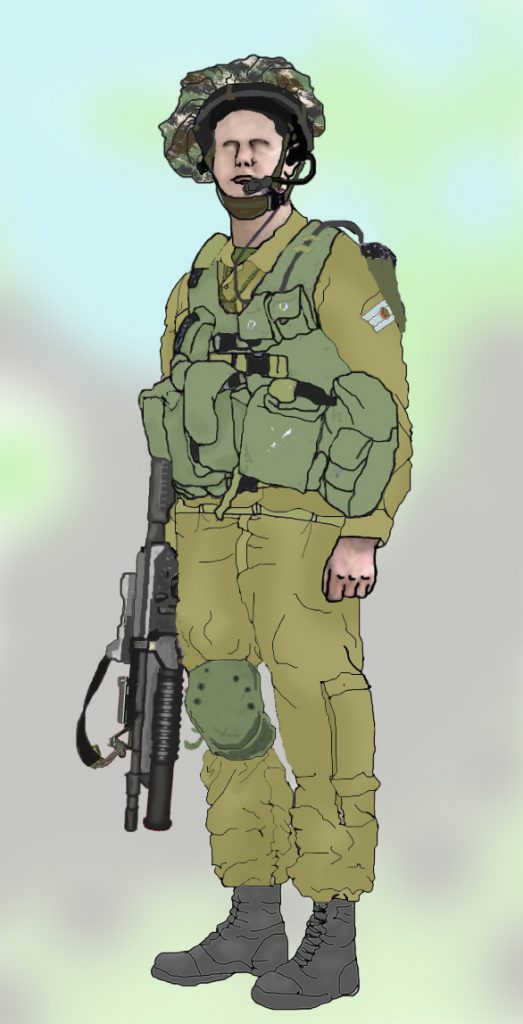Golani warriors fail to immediately engage enemy, suffer wounds, get reassigned to non-combat duty

Copyright: Jakednb [CC BY-SA 3.0 (https://creativecommons.org/licenses/by-sa/3.0)]
Drop (fall down to the ground), crawl (to obtain cover), observe (where the enemy fire is coming from), range (close the range to the enemy so that he can be efficiently eliminated), fire (lay down massive amounts of fire to eliminate the enemy). The Hebrew acronym for this, PAZATZTA, is burned in my mind to this day. I still remember when, in the squad commander course I took with the Golani brigade, our young lieutenant would yell at us “murder in your eyes, knife between your teeth” as he fired bursts of live fire just over our heads from his Galil rifle. The knife part was purely metaphorical, but the lust to murder the enemy, to close the distance to him and to lay upon him massive amounts of fire power until he is as dead as anyone could ever be, was a fundamental value that would stay with us forever.
We would run uphill and fire, fall down and fire, we would fire at the dummies representing enemy soldiers until we were inches from them, we would hit them with our rifle butts and we would fire at them again, point blank, to “verify the kill”. “Closing with the enemy”, “striving to make contact with the enemy”, “neutralizing the threat of the enemy”, those are the fundamentals that are drilled into every Israeli warrior. Alas, that is not what happened when, about a month ago, a single armed Arab approached the fence separating Gaza from Israel.
The incident began according to plan. A female soldier, one among many who observe the Gaza border day and night using a variety of sensors, detected the enemy approaching the border fence at two o’clock in the morning armed with a Kalashnikov rifle. A nearby patrol consisting of a jeep, a driver, and a squad of two warriors and the squad leader, a sergeant from the Golani brigade was dispatched to the area. Upon arriving at the scene, the Israeli soldiers exhibited indecisiveness, failing to close the range to the enemy and immediately kill him. Instead, a fire fight ensued giving the enemy time to lob a hand grenade, resulting in one of the soldiers receiving a ricochet wound and another suffering from a busted ear drum. Reinforcements under the command of a platoon leader with the rank of lieutenant were called to the scene, at which time they eliminated the threat by killing the enemy.
The commander of the Golani brigade, Colonel Shlomi Binder, led an inquiry into the incident, as a result of which the sergeant and two warriors under his command were relieved of combat duty and reassigned to non-combat roles. Simultaneously, the jeep driver was relieved of duty by the commander of the battalion in charge of the Gaza border.



5 comments
Why did not the female solider put a slug into him first? Why call anyone?
The observers are at a remote location, they watch screens with various sensor readings in a darkened room.
I’d like to see the other side of the story. How many have been vilified for over reacting, perhaps even being prosecuted? One of the terrorist tactics is to shove children into the line of fire, and sometimes I would imagine that there is some restraint used until the targets can be specifically identified. Even in a well defined kill zone, that tactic may backfire.
Legion57 Because you have a reading comprehension problem. She monitors sensors, cameras, vibration detection and night vision
DOC What other side of the story? Man approaches fence, Man climbs over fence, man is armed with an AK-47. I guess he was going sheep hunting? Man with AK-47 dead.
What other side of the story did you want to see? He crossed into no mans land and he is not oblivious to the fact if he does, he will be killed.
Perhaps the other side referred to by DOC was the soldiers side. I also doubt they were afraid of the enemy. Rather they were afraid of running afoul of the rules of engagement and got caught in a quandary not necessarily of their own making. That being said, they should have laid enough fire on that guy to stop him from lobbing the grenade.